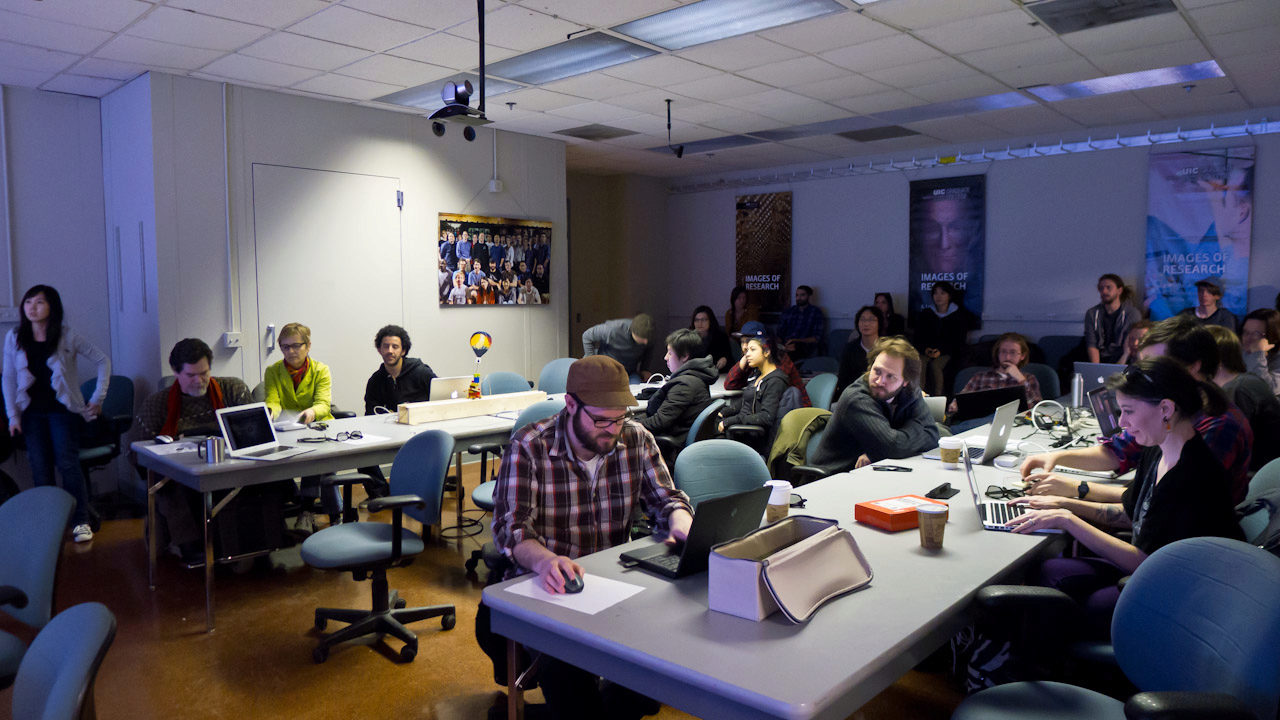Processing Chicago | February 2012
February 6th, 2012

About
The first meeting of Processing Chicago was a great success, with ~50 attendees. The presentations ranged from building a wearable EMF detector to a wind-controlled, telematic Arduino project. Below are links to PDFs and/or source code from several of the presentations.
Stereoscopic Display Test Pattern
EVL graduate student and research assistant Brad McGinnis discussed various types of stereoscopic 3d, and methods for detecting ghosting (or “cross talk”) in stereoscopic displays. He demonstrated the Weissman pattern he created with Processing that enables evaluation of ghosting in interlaced sterescopic displays. The Weissman pattern image can be found here.
Getting Started with Supercollider and Processing
EVL artist and researcher JD Pirtle gave a tutorial on getting started with Supercollider, and how to interact with Supercollider using Processing. Beginning with the basics of the structure of Supercollider and introductory sound synthesis and routing, JD then discussed techniques for using a Processing sketch to communicate with Supercollider via OSC (Open Sound Control). The source code (zip file) for the presenatation can be found here.
Homebrew Embedded Systems: OpenGL for the Sony PlayStation 3
Alex Betts, senior research programmer at the National Center for Supercomputing Applications, presented RSXGL, the OpenGL library he created for a rooted Sony Playstation. Alex discussed the various stages of this project, including the major accomplishments and future goals. The PDF of the presentation can be found here.
Wearable EMF detector
UIC Art History PhD and New Media Arts MFA candidate Tiffany Funk presented her wearable electromagnetic field (EMF) detector, which uses a Lilypad Arduino. The device allows users to navigate spaces while monitoring EMF levels, facilitating the measurement of exposure and energy consumption. A PDF of the presenatation is linked here.
Networked Arduinos
Researcher Brenda Lopez and research assistant Paolo Guerra from EVL’s Learning Technologies Group presented their recent work, a telematic Arduino project that utilizes a wind sensor and two networked Arduinos. By blowing into the wind sensor on one end, the user moves a small car on a track at the other end.
DIY Variable Voltage Power Supply
EVL PhD student and research assistant Victor Mateevitsi gave a tutorial on making a simple, yet effective variable voltage power supply. This device regulates power supplies by constraining the voltage to a specifc level. A PDF of the tutorial is linked here.
Arduino with an MP3 trigger via serial communication
New Media Arts MFA candidate and EVL research assistant Jon Chambers presented his recent work using an Arduino with an MP3 trigger. This device enables the embedding of triggerable audio into small environments where a computer would be impractical, such as in a sculpture. A PDF of the talk is here.